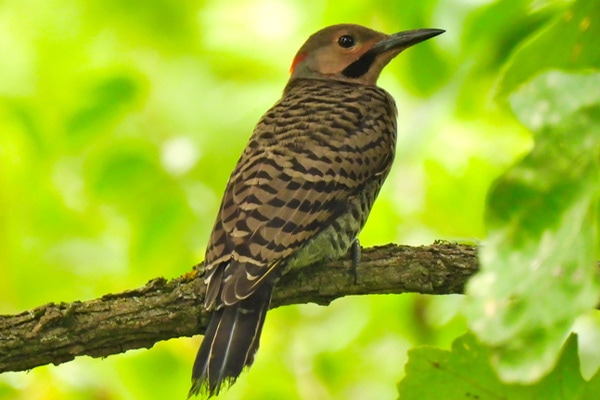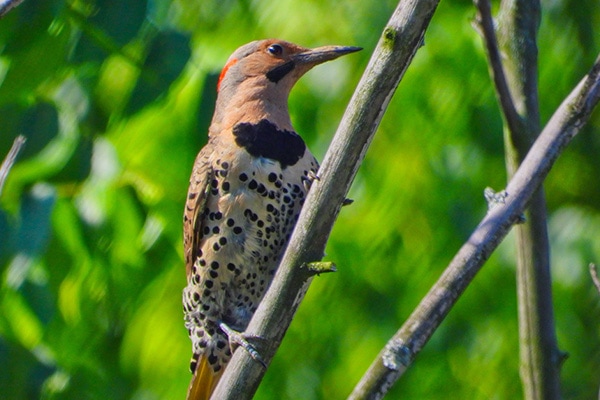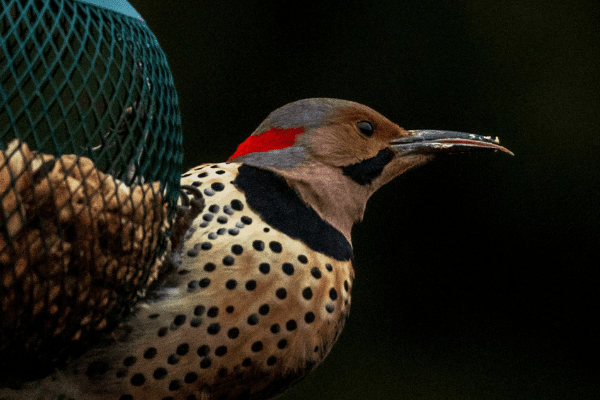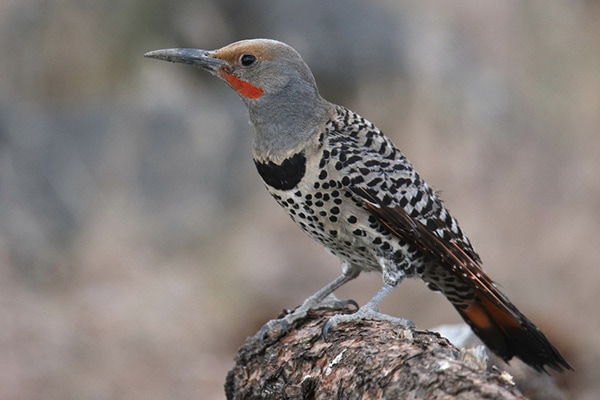Contents [show]
The Northern Flicker is a widespread bird in North America. They are clean and neat-looking with a gentle expression written on their faces. There are two forms – the Yellow-shafted Flicker and the Red-shafted Flicker, and in this article, we’re going to learn more about these birds.
We’ll discuss:
- How to identify them
- Where you’ll find them
- What they eat
- How they nest
- Their behaviors
- How to attract them
- Their conservation status
- Interesting facts
So if you want to learn more about these birds, read on as we go through all bird facts…

Northern flicker facts
- Common Name: Northern Flicker
- Scientific Name: Colaptes auratus
- Scientific Family: Picidae
- Life Span: 9.2 years
- Size: 11.0 to 12.2 inches
- Wingspan: 16.5 to 20.1 inches
- Weight: 3.9 to 5.6 oz
- Conservation status: Low Concern
Northern flicker: how-to identify
Northern Flickers are quite large woodpeckers that feature a slim head and downcurved bill. They are about half as big as hair woodpeckers and grow at about 11.0 to 12.2 inches in length, 3.9 to 5.6 ounces in weight, and have a 16.5 to 20.1 inches wingspan.
The birds showcase an overall brown plumage – brown back and wings with black bars, black crescent on their upper breast, and beige-colored breast with black spots. They also feature a white rump that is only visible in flight, and their upper tails are of dark color.
Apart from the overall features, Northern Flickers have two variations – Yellow-shafted and Red-shafted – showing some significant differences.
Yellow-Shafted species are those that showcase entirely yellow undertails and underwings. They also have yellow shafts, a red crescent on their nape, and a gray cap.
Red-Shafted species, on the other hand, showcase entirely red undertails and underwings. They have red shafts, brown crowns, and a gray face.
Differences Between Male & Female
There is very little difference between a male and female Northern Flicker. Male yellow-shafted northern flickers have black whiskers while females don’t, and male red-shafted northern flickers have red whiskers that females don’t have.
Differences In Summer Plumage vs Winter Plumage
Northern Flickers don’t change colors regardless of the season.
Northern flicker bird vocalization
Where You’ll See Northern Flickers
Northern Flickers have a wide geographical range. They breed from Alaska to Canada, stay all year round in the US, and winter in the south including some areas of Mexico and northern South America.
Yellow-shafted Northern Flickers are the ones mainly found in the eastern parts of the United States and Canada, while the Red-shafted Northern Flickers are those you can find in the western parts of the United States and Canada.
These birds are found in a variety of habitats, including woodlands, forest edges, city parks, and open fields with trees around. They can also be found in many burned forests, clear-cut areas, residential areas, and wet areas like flooded swamps.
Northern flicker diet
Northern Flickers, like many other woodpecker species, eat insects the most which include ants and beetles. However, unlike other woodpeckers, these birds search for their food by drilling on the ground instead of on the tree.
They also don’t just depend on insects for food sources. They also eat fruits and seeds, especially in winter when insects are scarce. This includes dogwood, sumac, grapes, sunflower seeds, hackberries, elderberries, thistle seeds, and more.

Northern flicker nesting
- Clutch Size: 5-8 eggs
- # of Broods: 1 brood
- Incubation Period: 11-13 days
- Nestling period: 24-27 days
- Egg Description: All White
Northern Flicker’s breeding season usually occurs from the months of February to July. These birds excavate their nesting sites in trunks or large branches of dead or diseased trees. They excavate holes about 6-15 feet off the ground, and oftentimes, they reuse the same cavities for the next breeding season.
Both the male and female birds help with the excavation. It’s usually a 13-16 inches deep cavity with a 3-inches in diameter entrance and lined with wood chips.
Both parents help with the incubation and oftentimes, their young remains with the parents even after the nestling period is over.
Northern flicker behavior
Northern Flickers are not like any typical woodpecker. These birds mainly forage on the ground instead of trees, and they perch on horizontal branches instead of hitching up tree trunks.
These birds can get aggressive when needed. Males defend their territories by aggressive calling, drumming, and showing aggressive displays, which include swinging their heads and spreading their tails. In courtship, some rival birds even face off in a fencing duel.
How-to attract northern flickers
Northern Flickers are accustomed to human settlements. They visit backyards, and since they have wide breeding and nonbreeding ranges, there is a good chance that they can pay you a visit.
To ensure that, make your yard more friendly for them. Provide them food, shelter, and water.
As these birds feed on insects on the ground, making your yard more insect-friendly will help. You can also plant some fruit-bearing or seed-bearing plants to accommodate their other food needs. Try to hang bird feeders filled with sunflower seeds and thistle seeds, and if you’re attracting them during winter, hang some suet feeders, too.
If you want to attract a pair during the breeding season, setting up a nest box would help catch their attention. Or if you have dead or diseased trees standing around, don’t cut them if you think it’s still safe.
Lastly, set up a heated birdbath so these birds can still get water, especially in winter.

Northern flicker threats
Northern Flickers are widespread in all of North America, this is despite the slight decrease in their populations. For this reason, these birds are classified as species of low concern.
Northern flicker fun & interesting facts
- Northern Flickers prefer to find their food on the ground than in trees.
- The red-shafted and yellow-shafted forms of Northern Flickers were once considered different species.
- They are one of the few species of North American woodpeckers that are strongly migratory.
- The oldest recorded yellow-shafted form of Northern Flicker was 9 years and 2 months old, while the oldest recorded red-shafted form of Northern Flicker was 8 years and 9 months old.
- Williamson’s Sapsucker
- Yellow-bellied Sapsucker
- Red-naped Sapsucker
- Red-breasted Sapsucker
- Lewis’s Woodpecker
- Acorn Woodpecker
- Gila Woodpecker
- Golden-fronted Woodpecker
- Red-bellied Woodpecker
- American Three-toed Woodpecker
- Black-beaded Woodpecker
- Downy Woodpecker
- Nuttall’s Woodpecker
- Red-headed Woodpecker
- Ladder-backed Woodpecker
- Hairy Woodpecker
- White-headed Woodpecker
- Arizona Woodpecker
- Ivory-billed Woodpecker
- Pileated Woodpecker
- Red-cockaded Woodpecker
- Gilded Flicker

